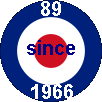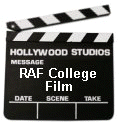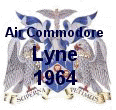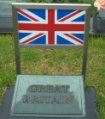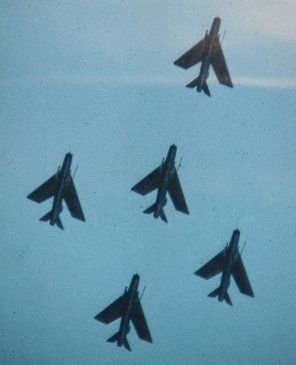|
Email your photos & stories |
|
For the Korean War site by Simon Coy
|
Cranwell
LINKS
FUN IN THE SUN OR EVERYONE SHOULD DO THEIR FIRST TOUR AS A FLYING OFFICER ON A FIGHTER SQUADRON OVERSEAS
By Andy Griffin 89B
56 Sqn moved to RAF Akrotiri in 1967 to replace the resident Javelin sqn. Postings were frozen for a while to allow them to settle in. In the meantime, I was completing the Lightning OCU in June 1968. There were 4 of us on the course (including Ron Shimmons & Frank Whitehouse) and rather unconventionally an instructor gathered us together and announced that there was one posting to Singapore (74 Sqn) one to Cyprus and 2 to Wattisham; he assumed that the first out of the hat would go to Singapore (Frank) and second to Cyprus and the other 2 to Wattisham. My name came out second and I became the first first-tourist to go to 56 in Cyprus.
The squadron seemed very experienced and settled to me and not a little daunting. It had more or less written its own rules and training schedule, which was great deal more realistic than in UK. Examples included combat training down to 7,000ft while the UK squadrons were restricted to 20,000ft and a great emphasis on the daytime low-level fighter-bomber threat with target evasion up to 3G. Add to all of this the fact that the radar unit that provided our control and surveillance was at the same station with a detachment at the top of Mount Olympus where the radar could usually see a low level target at a range of 100nm, and we thought we were ready for anything. Our main limitation was that the sqn was equipped with the Lightning F3 with either 2 Red Top missiles or 2 Firestreaks. The F3 was a good aeroplane but it was very severely limited in fuel capacity. When the engines were upgraded from the F1, no effort was made to enlarge the air intake and so the installed thrust was no greater and the fuel consumption higher.
Our primary task was to preserve the integrity of the local airspace. We were required to hold 2 aircraft on 10 minutes standby during daylight hours (and 90 minutes at night). These were used to scramble, intercept and identify any aircraft that might be seen to threaten the sovereign base areas of Cyprus. This was extremely difficult to define, as the territorial waters stretched to only 12 miles, which was hardly enough to intercept an intruder travelling at say 8 miles a minute. In reality, we generally launched against anything which seemed to be heading towards Cyprus and was not identified as a civil flight. Our main day-to-day trade came from Soviet-manned TU16 “Badger” bombers used for maritime reconnaissance mainly monitoring the activities of the US 6th Fleet. They operated out of an airfield in Egypt called Cairo West and carried Egyptian markings. However, their CO obviously had a sense of pride and it was possible to distinguish the Soviet operated aircraft because the trim tabs were painted red. When I arrived on the squadron we had not achieved an interception against a Badger, because as we got airborne they always turned away. Clearly they were monitoring all our frequencies and we were naïve enough to announce on the R/T that the Battle Flight was “scrambling”: all very 1940 and gung ho!
Because the Lightning was desperately short of fuel, we were poorly placed to chase a receding target, and for a long time no successful intercept took place. It was quite frightening to be flying at very high speed away from base, watching the fuel gauges going down and failing to overhaul the target fast enough. Someone then came up with the bright idea of a completely silent scramble. The pilot was carefully briefed on land line and took off without any calls, accelerating to Mach 1.3 at 25,000 feet. The ground radar would just pass ranges until we knew we could catch the target. We then turned our own radar on and completed the intercept. The target was visibly surprised the first time. From then on, interceptions became fairly routine and we managed to take some useful intelligence photographs – albeit with a very primitive clockwork-driven camera which was all that was available in those days. It was not easy to fly in close formation while taking pictures, but we seemed to manage.
Despite chronic aircraft unserviceability it was not all Battle Flight. It has been said in those days that you would meet the entire RAF if you stood in the Akrotiri mess bar for long enough and we were visited by countless detachments from the UK and en-route to the Far East. The squadron had a slightly unfair reputation for not being very hospitable, but there were only about 15 of us and there were visiting squadrons and detachments throughout the summer. The record for a kebab hosted by 56 in Limassol was 139 people.
When the Navy lost the battle with the RAF over the replacement for HMS Ark Royal, it was agreed (that's probably not the right word) that defence of the fleet would be carried out by land-based aircraft. (I well recall flying a single Mk 6 Lightning overhead the USS John F Kennedy with a sqn of F14s embarked, and not feeling that I was contributing a great deal to the defence of a free world with my 2 Red Tops). However, the new role led to an increase in the use of tankers to support long-range fighter operations. There was already some such going on, as AOC 11 Gp seemed determined to get UK QRA to intercept at 1,000nm. The cynics wondered why the fighters went at all. 1,000nm may not seem much to Tornado F3 and Typhoon drivers, but 100nm was a long way in a Lightning. (As an illustration of just how ridiculous the fuel load was, an F3 could take off from Coltishall, climb to FL360 and land at Lossiemouth with 20001b; minimum landing fuel was 16001b).
At Akrotiri we used to be visited by a Victor K1 tanker every few months to keep in AAR practice. To keep the stats going, we tended to spend a good deal of time just prodding, but the opportunity to use the tanker’s fuel properly was too good to miss. Long before defence of the fleet was a feature of the air defence role, someone decided that we could use the tanker to enable us to intercept visitors rather further away than the usual 30nm or so. On the day to which this sorry tale applies, we were due to be visited by the very first Phantom detachment (from 54 Sqn). We did not know a great deal about the Phantom's capabilities but we did know that it had a very much better radar than ours; and that there were 2 ex-56 pilots on the detachment. It had been our habit to intercept all fast-jet visitors; some reacted with boredom, others played the game and tried to get through. After much bar planning, it was decided to mount one of the first ever tanker CAPs at about 60nm west of Akrotiri. OCA and I were on the first pair and duly sat with the tanker awaiting GCI ideas. The plan was for a very slack set up culminating in a 90 intercept, which would keep us out of the 60 degree scan of the Phantom's radar. We were duly summoned from the tanker for a target and as planned set up in long line astern. My leader was some 10-15 nm ahead of me going well when he saw the target visually and announced, in somewhat miffed tones, that it was a Vulcan and he was going back to the tanker.
At this stage a voice I recognized came on the R/T and said he had the real target; 27 miles on the nose! (We wanted a slack intercept but this was ridiculous). However, with the defence of the Near East resting on my youthful shoulders this was no time for caution. To cut a long story short, the Phantoms were doing about 480kts and, as I failed to notice, descending from cruise altitude to low level. I pressed on regardless and eventually claimed my kill at about 3,000ft. What I signally failed to check was the fuel state and the distance from base. (The TACAN was unlocked anyway). Normally this would have been no real problem as most intercepts were very close in, but this was 110nm away and my fuel was exactly that required to divert from Akrotiri to Nicosia. (These were the only airfields on the island in those days). 650kts gets you to height quite quickly, but there seemed to be a great deal more sea between me and the runway than there was fuel in the tanks. Fortunately there were more professional aviators around than I that day and the tanker captain, who was a splendid character called Jock Carrol (OC Standards at Marham I think) was doing his Mach 0.72 best to keep up. The threat of a few MAYDAY calls got a good heading to the tanker and while Jock swapped OCA from the good hose to the dodgy one, l completed the smoothest tanker join and contact in history; none of this joining-on-the-port-and waving-at-the-captain stuff! Actually, l think he backed it on. I didn't go below 20001b fuel for weeks after that.
REHEAT ROTATION
I hope most who read this are old enough at least to have seen a Lightning reheat rotation. Some, of course, were around when the manoeuvre was invented and if I talk nonsense about it, I hope they will forgive me.
It seems amazing today, but the manoeuvre was considered to be part of an OCU student’s repertoire. I recall being taught how to fly it with about 20 hours on type. The technique was simple; a reheat take-off, accelerate to 240 kts and pull 3G/heavy buffet with the wings level to 45 - 60o angle of climb. The aircraft would climb away steadily at 190 kts using fuel at approximately 20lb a second. The first student reheat take-off, let alone rotation, was always worth watching, as the Mk1’s nosewheel jack was not of the strongest and the leg retracted forward. It was common for the tyro to fail to raise the gear quite quickly enough and be seen climbing away very steeply trying to keep the speed below 220kts. For some reason, no-one thought of deselecting burner, they just hauled up the nose. This was not a true rotation as the aircraft never entered buffet. One display pilot, who served on 56, used to combine both factors by delaying gear up, so that he rotated at just under 220 kts with the nosewheel held down by the airspeed. It was a beautifully precise manoeuvre; didn’t do his career any harm either!
A rotation take-off was part of the QFI check on joining 56. Towards the end of a difficult 1968, when the Squadron had been forced to bolt-hole to Nicosia while the Akrotiri runway was resurfaced, the Boss decided that come what may, we were going to be the first F3 Sqn ever to complete the annual hour’s task - 240hrs per pilot. Two other decisions were that we would attend the New-Year’s Eve party as a squadron (dressed as red and white crusaders as I recall), but start the way we meant to go on with an 0700 take-off on 1 Jan. I have a vague recollection of leading OCA up the climb at about 190kts upsetting the residents of Akrotiri at 0730 in the morning. In fact the first pair did get off at 0700 and we continued with a reheat take-off at 0700 every morning. After a while, the Station Commander’s sense of humour failed as he could not hear the news headlines on the BBC World Service, and the first take-off was brought forward to 0655. We achieved the task and had a long break at Christmas.
Life went on and we held a squadron open day. There were 5(!) serviceable aircraft and we put up a 4-ship and solo aerobatics display. I had more or less cornered the “no-brains” No 4 slot in the Sqn team, which used to fly around in and out of burner in a variety of formations. The plan was to fly a 4-ship 2-second stream rotation take-off on 09* and rotate at the end of the runway so as to be alongside the Akrotiri fighter dispersal and in view of the visitors. The leader took off and flew quite normally, but No2 had a runaway yaw autostab shortly after liftoff; he very reasonably flew rather gently round a curve cancelling reheat the while. No3 only got 1 reheat. Never one to hold back (or think sensibly!) I was lucky enough to be in an aircraft known to be quite quick (and they did vary) and with no missiles loaded. I was in fighting wing with the No3 by the time I got to the 27 threshold and doing about 320kts. I pulled at least 5G but it had no effect on the acceleration of my steed which seemed determined to challenge for the lead. I rolled No4, rotated No3 and went off the top at about 4000ft as No2!
Not long afterwards rotations were banned, except for display pilots. The reason was a fatal accident in Singapore which had nothing to do with the intrinsic safety or otherwise of the manoeuvre. In reality, the F6 could not fly a proper rotation because it was simply too heavy.
* The wind was irrelevant. The F3 could take 30 kts down wind, lose an engine at less than 90 kts and still happily get off 9000 ft: Jaguar pilots eat your heart out!
| BEWARE OF GREEKS
The 4-ship display team was a fairly modest effort, but at our best we did coordinate with a solo display and flew a number of different formations including swan and card. On one adventurous day we decided to do a 5-ship take-off with the solo as No 5. The vic-5 lined up on 09 with a spanking new centreline painted on the runway. I was outside right and as I lined up I remember thinking to myself that it looked a bit tight but since no one else said anything I had better shut up and get on with it. We happened to have a visiting professional photographer flying in the Sqn’s Canberra target aircraft, and with great skill our tame Canberra pilot was right over the top to allow him to photograph the take off as it rolled. We seemed to get airborne successfully but No5 complained afterwards that he thought it was a bit tight and the slipstream from No3 had turned him on his back! The photographs revealed that while my wing tip was in line with the edge of the runway, his was well over it and the edge was midway between the tip and the main-undercarriage leg. He had very reasonably felt that he had to sit back slightly and as the nose wheels were raised, the No 3’s wing-tip vortex just lifted his inside wing. I kept quiet about thinking it was a little tight on my side. The moral of the story is beware of Greeks painting runway centrelines; they just might not be in the middle. |
|
I was lucky to serve on a squadron under 2 flight commanders with considerable vision. The first was largely responsible for the different and very realistic way of training that 56 adopted. The second helped me enormously and allowed a callow youth to avoid too many mistakes. Although we suffered from terrible unserviceability and poor aircraft availability – to the extent that 11 Squadron had to be deployed to help us cover the Battle Flight commitment – the flying was excellent and we enjoyed a first-class relationship with 280 Signals Unit, our resident control and reporting radar unit. Some of the Squadron’s tactics led the way to improvements in the way the UK squadrons operated. We were lucky to have so many visitors so we could practise against a variety of threats from resident Canberras and later Vulcans, through visiting Buccaneers, Phantoms and Harriers. I remain eternally grateful that I drew this wonderful tour out of a hat – not to mention my wife who served at 280 SU.

